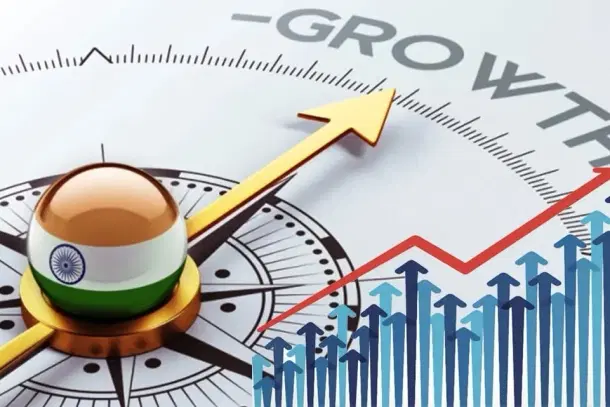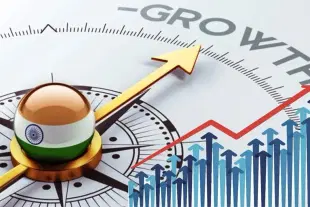Economy
What Will Drive India's GDP To The $7 Trillion Mark? Here's What CRISIL's 'Progress Report' On Indian Economy Says
Vansh Gupta
Nov 21, 2024, 04:54 PM | Updated Nov 22, 2024, 06:58 PM IST
Save & read from anywhere!
Bookmark stories for easy access on any device or the Swarajya app.


India’s economic trajectory is on the cusp of significant milestones, with a remarkable $7 trillion GDP mark anticipated by fiscal 2031. According to a recent CRISIL report, India’s real GDP growth is expected to sustain an impressive 6.7 per cent annually during the fiscal years 2025-2031.
Nominal GDP is projected to grow from $3.6 trillion in fiscal 2024 to $7 trillion by fiscal 2031. At this stage, India would transition into the upper-middle-income category, with per capita income nearing $4,500, the report noted.
A similar outlook is echoed by S&P Global Market Intelligence, which predicts India’s nominal GDP to nearly double by fiscal 2031. With this growth, India is poised to become the third-largest economy in the world, increasing its share in global GDP from 3.6 per cent to 4.5 per cent.
S&P attributes this momentum to India’s resilient external buffers, including a sharply narrowed current account deficit (0.7 per cent of GDP in fiscal 2023-24 compared to 2.0 per cent the previous fiscal).
S&P also highlights strong economic indicators, such as robust Purchasing Managers’ Index (PMI) readings for manufacturing and services, rising GST collections, improving compliance, increased capacity expansion, new work intakes, and productivity gains as factors instrumental in achieving the expectations it projected.
Covid-19's Limited Impact On Growth Milestones
Despite the disruptions caused by the Covid-19 pandemic, India remains on track to achieve a $5 trillion economy by fiscal 2027 and the $7 trillion target soon after, the CRISIL's report noted. The resilience stems from two key factors:
1. Limited deviation from pre-pandemic trends: Nominal GDP in fiscal 2024 was only 2.4 per cent below its pre-pandemic trajectory.
2. Slow Rupee depreciation: The rupee weakened by an average of 4 per cent during fiscal 2021-2024, compared to 4.3 per cent in the preceding decade.
In addition, the post-pandemic recovery has been supported by government infrastructure initiatives and household investments. However, private-sector corporate investments, which account for 37 per cent of total investments, are yet to gain significant traction.
Despite this, initiatives like the Production Linked Incentive (PLI) scheme and a competitive corporate tax regime have created a conducive environment for future investments, according to the report.
CRISIL’s Growth Enablers
The CRISIL report has identified several growth drivers which form a basis of its expectation and, simultaneously, position India for sustained growth:
1. Deleveraged corporate sector: CRISIL Ratings’ analysis shows that the private sector’s capex potential has risen three-fold over the past decade, following a long spell of deleveraging and profit growth.
2. A healthy banking sector has improved India’s ability to finance growth. This is visible in sustained strong bank credit growth since fiscal 2023. Gross non-performing assets (GNPAs) remained low at about 2.5 per cent as of March 2024, suggesting banks have headroom for robust credit offtake.
3. Innovative financial products have increased avenues to raise capital. Products such as infrastructure investment trusts (InvITs), real estate investment trusts (REITs) and restricted groups (RGs) have risen in prominence, helping attract domestic and foreign funds.
4. The government's implementation of process reforms, such as GST, the IBC, and the Real Estate (Regulation and Development) Act, has improved the ease of doing business in India.
Next Stage Reforms As Catalysts For Growth
CRISIL’s analysis also emphasises the necessity of next-stage reforms to unlock efficiency gains and sustain high growth rates. Key areas include:
1. Land Reforms: Streamlining land acquisition processes and improving land record transparency can facilitate investments in infrastructure and industry.
2. Labour Law Simplification: Easing labour laws shall improve flexibility and attract both domestic and foreign investments.
3. Agricultural Reforms: Enhancing agricultural infrastructure, fostering investments, and improving price discovery mechanisms for farmers can boost productivity in the sector.
Additionally, India’s commitment to innovation and technology-driven reforms has been crucial. The rollout of initiatives like the Digital Agriculture Mission and the development of over 2,000 climate-resilient crop varieties have strengthened food security and driven inclusive growth.
Potential Risks To Economic Aspirations
While the outlook is optimistic, CRISIL warns of several potential risks that could derail the $7 trillion goal:
1. Geopolitical Instability: Escalations in conflicts, particularly in the Middle East, could disrupt crude oil supplies and increase logistics costs, straining India’s economy.
2. Climate Change: The rising frequency of extreme weather events poses a challenge to agricultural productivity. For instance, India experienced its second hottest year and driest August in 123 years in 2023, which dragged agricultural growth to 1.8 per cent in fiscal 2024 from 4 per cent the previous year.
3. Decarbonisation Challenges: Infrastructure and manufacturing, the two pillars of India’s growth, are heavily carbon-intensive. Balancing decarbonisation efforts with economic expansion remains a formidable challenge.
4. Global Indebtedness: With global debt-to-GDP ratios at 231 per cent in 2023, high leverage amid rising interest rates could precipitate financial crises, affecting India’s trade and investment flows.
While risks persist, the Indian economy appears well-positioned to achieve this milestone. As CRISIL notes, the interplay between productivity gains and strategic policymaking will be pivotal in reaching the $7 trillion dollar target.
Vansh Gupta is an Editorial Associate at Swarajya.




